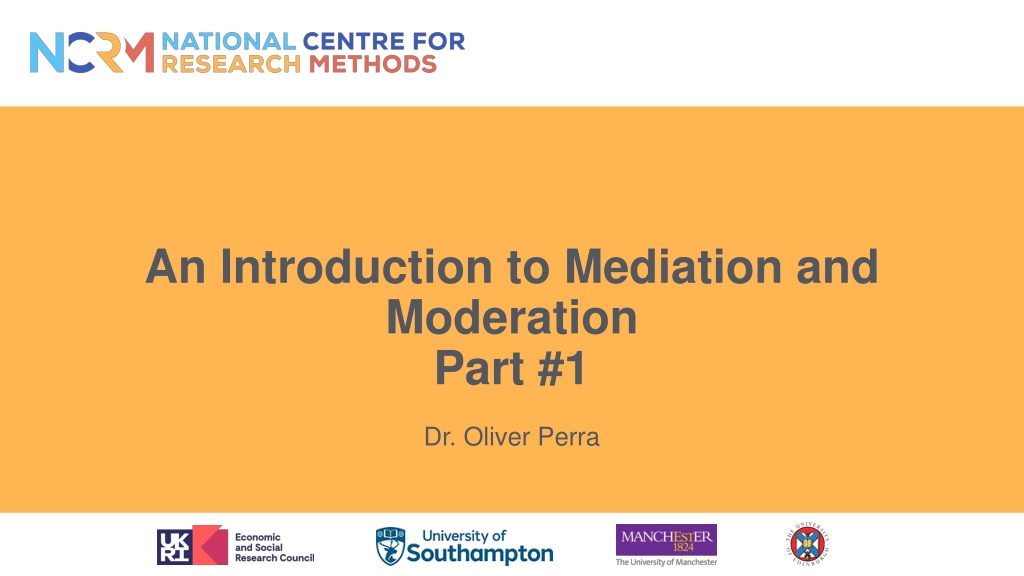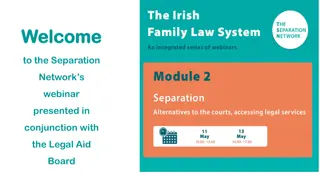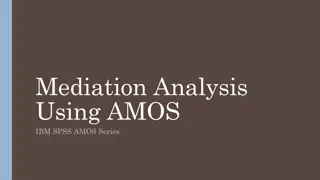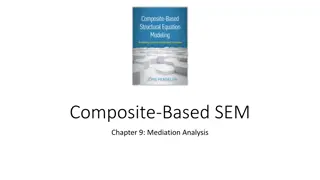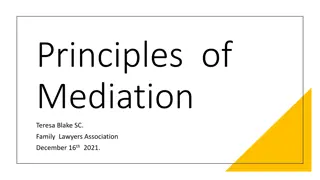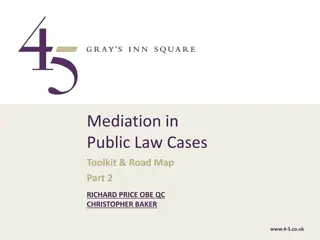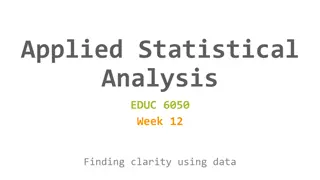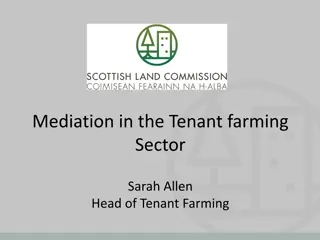Understanding Mediation vs. Moderation in Research
This introduction explores the concepts of mediation and moderation in research, distinguishing between how predictors influence outcomes and when they do so. It covers practical examples of mediation models, the role of mediators and moderators, and the importance of considering the relationship between predictors and outcomes.
Download Presentation

Please find below an Image/Link to download the presentation.
The content on the website is provided AS IS for your information and personal use only. It may not be sold, licensed, or shared on other websites without obtaining consent from the author. Download presentation by click this link. If you encounter any issues during the download, it is possible that the publisher has removed the file from their server.
E N D
Presentation Transcript
An Introduction to Mediation and Moderation Part #1 Dr. Oliver Perra
Summary Mediation vs. Moderation Example of simple mediation model Practical example of mediation model The case against the causal approach
Mediation vs. Moderation Mediator: Accounts for the relation between predictor and outcome
Mediation vs. Moderation Mediator: Accounts for the relation between predictor and outcome Med X Y
Mediation vs. Moderation Mediator: Accounts for the relation between predictor and outcome Treatment
Mediation vs. Moderation Mediator: Accounts for the relation between predictor and outcome Self-efficacy Depression Peer-Support
Mediation vs. Moderation Mediator: Accounts for the relation between predictor and outcome Moderator: Qualifies the association between predictor and outcome Mod X Y
Mediation vs. Moderation Moderator: Qualifies the association between predictor and outcome Personal involvement Strength of Argument Changes in Attitudes Environmental taxes
Mediation vs. Moderation Moderator: Qualifies the association between predictor and outcome + Personal involvement Strength of Argument Changes in Attitudes - Personal involvement Strength of Argument Changes in Attitudes Environmental taxes
Mediation vs. Moderation Mediation: Howpredictors influence outcomes Moderation: When andfor whompredictors influence outcomes
Simple Mediation Model Med X Y
Simple mediation model Mediator: Accounts for the relation between predictor and outcome M X Y
Simple mediation model M a a b b X Y c c c ?????? ?????? ? ? ?,? ???????? ?????? ? ?
Simple mediation model: Ordinary Least Squares ?? M a a b b ?? X Y c c ? = ??????????+ ? (?) + ?? ? = ?????????? + ? (?) + ? (?) + ??
Simple mediation model: Ordinary Least Squares ?? M a a b b ?? X Y c c Direct Effect X Y: ? = ??????????+ ? (?) + ?? ? = ?????????? + ? (?) + ? (?) + ?? ? = ? | ? = ?,? = ? ? | ? = ? 1 ,? = ?
Simple mediation model: Ordinary Least Squares ?? M a a b b ?? X Y c c Direct Effect X Y: ? = ??????????+ ? (?) + ?? ? = ?????????? + ? (?) + ? (?) + ?? ? = ? | ? = ?,? = ? ? | ? = ? 1 ,? = ? c is the estimated difference in Y for a unit change of X while holding M constant; adjusted difference.
Simple mediation model: Ordinary Least Squares ?? M a a b b ?? X Y c c ? | ? = ? ? | ? = ? 1 ? = ? = ??????????+ ? (?) + ?? ? = ?????????? + ? (?) + ? (?) + ?? a is the estimated difference in M for a unit change of X.
?? M a a b b ?? X Y c c ? | ? = ? ? | ? = ? 1 ? = ? = ??????????+ ? (?) + ?? ? = ?????????? + ? (?) + ? (?) + ?? ? = ? | ? = ?,? = ? ? | ? = ? 1,? = ? b is the estimated difference in Y for a unit change of M, while holding X constant.
Simple mediation model: Ordinary Least Squares ?? M a a b b ?? X Y c c The indirect effect of X ? ? Y: ? = ??????????+ ? (?) + ?? ? = ?????????? + ? (?) + ? (?) + ?? Cases that differ by one unit on X are estimated to differ by ab units in Y as a result of the effects X M and M Y
Simple mediation model: Ordinary Least Squares ?? M a a b b ?? X Y c c The total effect of X ? = ? | ? = ? ? = ? + ?? Y: ? | ? = ? 1 ? = ??????????+ ? (?) + ?? ? = ?????????? + ? (?) + ? (?) + ??
Simple mediation model: Ordinary Least Squares ?? M a a b b ?? X Y c c The total effect of X ? = ? | ? = ? ? = ? + ?? ; ? ? = ?? ; Y: ? | ? = ? 1 ? = ??????????+ ? (?) + ?? ? = ?????????? + ? (?) + ? (?) + ??
Practical Example Med X Y
Example: Students in Grade 8 and 12 Students assessed in standardised scores of Maths and Reading at grade 8 and grade 12. Some attended private High Schools. Let s focus on Family Income at Grade 8 and reading: Family Income was dichotomised to represent families with higher income. ??12 Math12 HighInc8 c c
Example: Students in Grade 8 and 12 Students assessed in standardised scores of Maths and Reading at grade 8 and grade 12. Some attended private High Schools. Let s focus on maths and reading: ??8 Read8 a a b b ??12 Math12 HighInc8 c c
Example: Students in Grade 8 and 12 Students assessed in standardised scores of Maths and Reading at grade 8 and grade 12. Some attended private High Schools. Let s focus on maths and reading: ??8 Read8 a a b b ??12 Math12 HighInc8 c c ?(????8) = ??????????+ ? (?_??? ???8) + ?? ? (??? 12) = ?????????? + ? (?_??? ???8) + ? (?_????8) + ??
Example: Students in Grade 8 and 12 Students assessed in standardised scores of Maths and Reading at grade 8 and grade 12. Some attended private High Schools. Let s focus on maths and reading: ??8 summary(lm(read8~highinc, data=d)) Read8 4.67 *** 4.67 *** b b ??12 Math12 HighInc8 c c ?(????8) = ??????????+ ? (?_??? 8) ? (??? 12) = ?????????? + ? (?_??? 8) + ? (?_????8) Read8 = 48.59 + 4.67 (HighInc8)
Example: Students in Grade 8 and 12 Students assessed in standardised scores of Maths and Reading at grade 8 and grade 12. Some attended private High Schools. Let s focus on maths and reading: ??8 summary(lm(math12~highinc+read8, data=d)) Read8 4.67 *** 4.67 *** 0.60*** 0.60*** ??12 Math12 HighInc8 2.43*** 2.43*** ?(????8) = ??????????+ ? (?_??? 8) ? (??? 12) = ?????????? + ? (?_??? 8) + ? (?_????8) Read8 = 48.59 + 4.67 (HighInc8) Math12 = 18.39 + 2.43 (HighInc8) + 0.60 (Read8)
Example: Students in Grade 8 and 12 Students assessed in standardised scores of Maths and Reading at grade 8 and grade 12. Some attended private High Schools. Let s focus on maths and reading: ??8 Read8 4.67 *** 4.67 *** 0.60*** 0.60*** ??12 Math12 HighInc8 2.43*** 2.43*** ?(????8) = ??????????+ ? (?_??? 8) ? (??? 12) = ?????????? + ? (?_??? 8) + ? (?_????8) Read8 = 48.59 + 4.67 (HighInc8) Math12 = 18.39 + 2.43 (HighInc8) + 0.60 (Read8) Indirect effect = ab = (4.67 * 0.60) 2.80
Example: Students in Grade 8 and 12 Students assessed in standardised scores of Maths and Reading at grade 8 and grade 12. Some attended private High Schools. Let s focus on maths and reading: ??8 process (data=d, y="math12",x="highinc",m="read8", total=1, normal=1, model=4, seed=90460) Read8 4.67 *** 4.67 *** 0.60*** 0.60*** Assumption of normal sampling distribution and use of Sobel test ??12 Math12 HighInc8 2.43*** 2.43*** Read8 = 48.59 + 4.67 (HighInc8) Math12 = 18.39 + 2.43 (HighInc8) + 0.60 (Read8) Indirect effect = ab = (4.67 * 0.60) 2.80
Example: Students in Grade 8 and 12 Students assessed in standardised scores of Maths and Reading at grade 8 and grade 12. Some attended private High Schools. Let s focus on maths and reading: ??8 process (data=d, y="math12",x="highinc",m="read8", total=1, boot=10000, model=4, seed=90460) Read8 4.67 *** 4.67 *** 0.60*** 0.60*** Requests 10k draws in bootstrapping ??12 Math12 HighInc8 2.43*** 2.43*** Read8 = 48.59 + 4.67 (HighInc8) Math12 = 18.39 + 2.43 (HighInc8) + 0.60 (Read8) Indirect effect = ab = (4.67 * 0.60) 2.80
The case against the Causal Steps Approach e M a a b b ? Y X t t c c
The case against the Causal Steps Approach (1) Cumbersome too many tests; (2) Indirect effect a*b may be 0 even if a and b are not; (3) Investigation stops if total effect is not significant: However, there may be mediation even if total effect is not significantly 0 e M a a b b ? Y X t t c c
Summary Mediation vs. Moderation Example of simple mediation model The case against the causal approach
